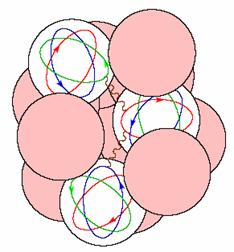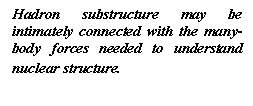Result 3
Hadronic Nuclear Physics
A particularly fundamental question of interest to both the nuclear structure and astrophysics communities is the origin of phenomena such as the observed "saturation" of nuclear binding within QCD itself: That is, the total binding energy of nuclei does not simply increase linearly with the number of nucleons, suggesting some kind of screening, or a reduction in nucleon interactions over the extended size of nuclei. Great progress has been made in understanding normal nuclei in terms of effective two- and three-body forces, derived either phenomenologically or through modern effective field theory based on the symmetries of QCD. A truly microscopic understanding of the origins of these effective descriptions at the quark and gluon level would allow one rather more confidence in extending such theories to regimes of density or neutron-proton asymmetry for which data is not yet available - for example at the densities found in the core of neutron stars or in nuclei with highly asymmetric numbers of protons and neutrons. Some progress has been made in relating the widely used Skyrme force to a quark-gluon level description of nuclei and this work needs to be continued. However, most importantly, this consideration makes the experimental challenge of measuring the changes of hadron properties immersed in a nuclear medium, discussed above, especially important.

